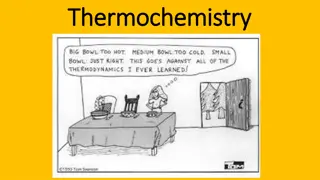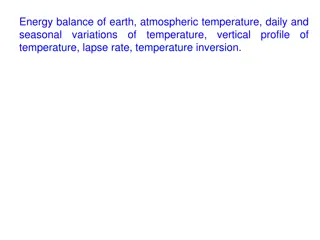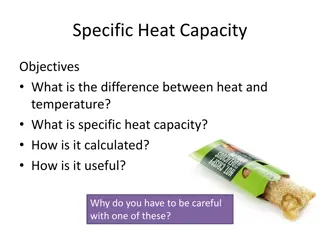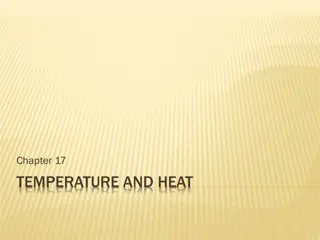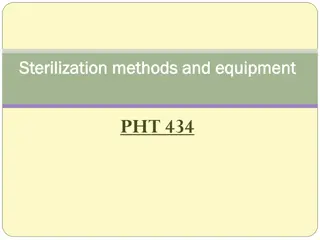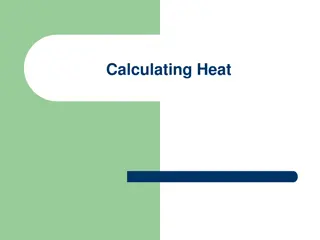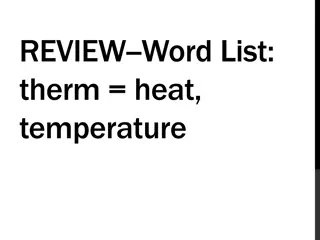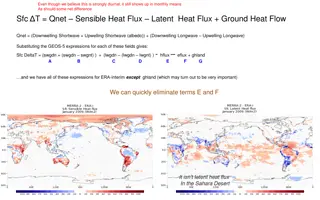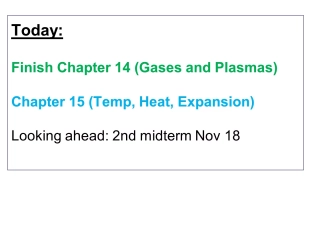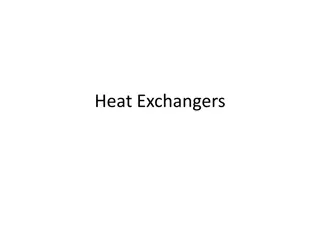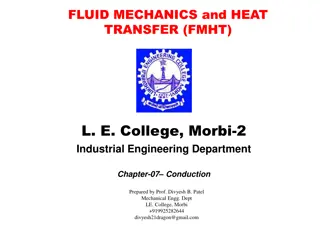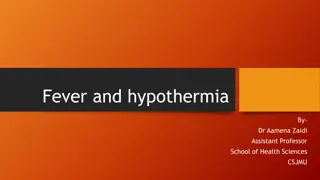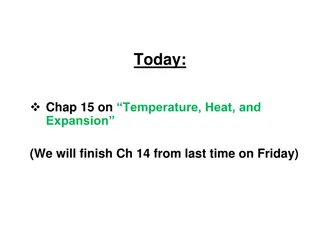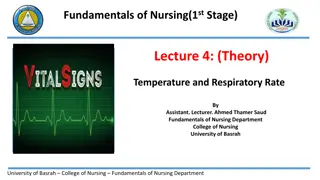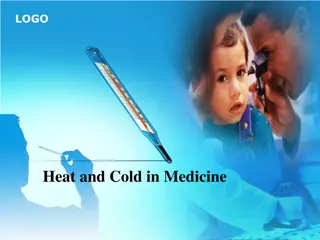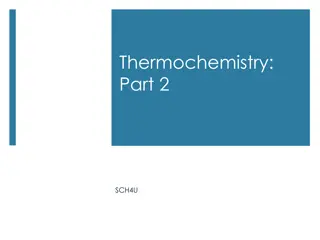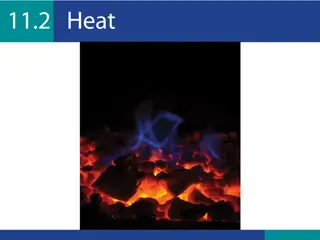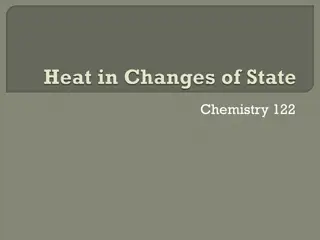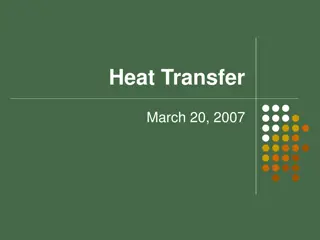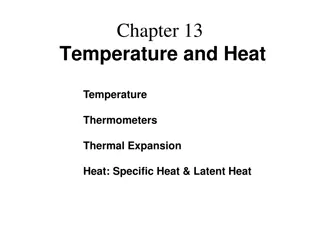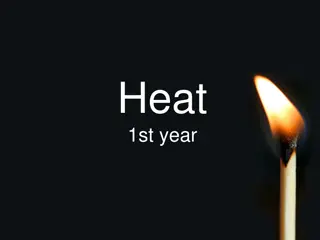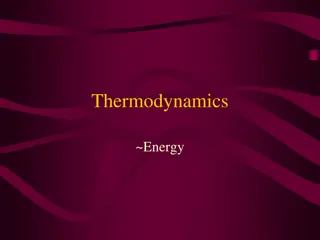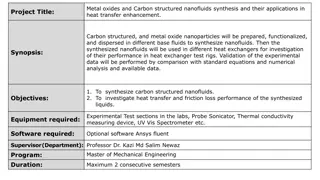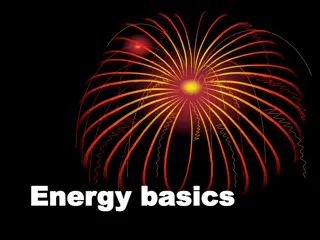Understanding Heat and Temperature Changes in Chemistry
Heat and temperature changes in chemistry are crucial concepts to comprehend. Heat capacity, molar heat capacity, and specific heat capacity play significant roles in determining temperature changes when heat energy is added or removed. Different substances have varying abilities to absorb heat, affecting the rate of temperature change. Tables of molar and specific heat capacities provide valuable reference information for different substances. Understanding these principles is essential for accurate calculations in chemical reactions and material behavior.
Download Presentation

Please find below an Image/Link to download the presentation.
The content on the website is provided AS IS for your information and personal use only. It may not be sold, licensed, or shared on other websites without obtaining consent from the author. Download presentation by click this link. If you encounter any issues during the download, it is possible that the publisher has removed the file from their server.
E N D
Presentation Transcript
Temperature changes compared to heat energy added Remember *this assumes NO chemical changes occur* the more heat added the more temperature change. *Unless we are at a phase change point!! The more matter present the less the temperature will change. The type of matter present also has an effect on the temperature change.
Heat capacity ~the rate of temperature change compared to the amount of heat energy added (or removed) with no chemical change for a specific substance. Every substance absorbs heat differently. Applying the same amount of heat to equal amounts of iron and water their rate of temperature change will differ. (The pan gets hotter much faster than the water)
Molar heat capacity We will mainly use molar heat capacity, which is the rate of temperature change per mole. It s symbol is C It is measured in J/(K mol) These will normally be givens in the problem.
Specific Heat Capacity Same idea as molar heat capacity, but it is measured per gram as opposed to per mole. It is necessary if you don t know what the metal is you are working with. Its symbol is c (its is written as s in your book, for the AP test it is c). It is measured in J /(K g)
Table of molar heat capacities C C Substance Substance Water (Liquid) 75.3 J / K mol Water (Gas) Water (Solid) Lead (Solid) Lead (Liquid) Iron Silver Cobalt Silicon Cadmium 25.2 J / K mol 28.8 J / K mol 29.1 J / K mol 24.2 J / K mol 24.2 J / K mol 254 J / K mol 50.5 J / K mol 26.1 J / K mol 25.2 J / K mol 25.42 J / K mol Helium Hydrogen Nitrogen Aluminum Tungsten Octane NaCl Nickel Zinc Gold 36.8 J / K mol 38.09 J / K mol 26.7 J / K mol 27.4 J / K mol 25.1 J / K mol 25.3 J / K mol 50.6 J / K mol 19.7 J / K mol 25.6 J / K mol
Table of specific heat capacities Substance c Substance c 4.183 J/K g 5.193 J/K g Water (Liquid) Helium 2.080 J/K g 2.05 J/K g 0.129 J/K g 14.30 J/K g 1.04 J/K g 0.891 J/K g Water (Gas) Water (Solid) Lead (Solid) Hydrogen Nitrogen Aluminum 0.132 J/K g 0.449 J/K g 0.233 J/K g 0.858 J/K g 0.701 J/K g 0.228 J/K g .132 J/K g 2.22 J/K g .864 J/K g 0.444 J/K g 0.388 J/K g .129 J/K g Lead (Liquid) Iron Silver Cobalt Silicon Cadmium Tungsten Octane NaCl Nickel Zinc Gold
Throwing it all into one equation The symbol for heat energy is Molar heat capacity is Temperature is T, change in temperature is T (K) T is calculated by final temp-initial temp (Tf-Ti) The symbol for number of particles is q (J) C (J/mol K) n (mol) q = n C T q = n C (Tf - Ti)
------Or------ The symbol for heat energy is specific heat capacity is Temperature is T, change in temperature is T (K) T is calculated by final temp-initial temp (Tf-Ti) The symbol for mass q (J) c (J/ g K) m (g) q = m c T q = m c (Tf - Ti)
Using this equation If 3940 J of energy is added to 43.9 mol of tungsten at 265 K, what will the final temperature be? q = n C T
Using this equation If 3940 J of energy is added to 43.9 mol of tungsten at 265 K, what will the final temperature be? q = n C T 3940 J = 43.9 mol (24.2 J/K mol) (Tf 265 K) Tf= 269 K *Always make sure all units agree, I will include several conversions in these problems.
And the other 14.2 g of an unknown metal is heated with 998 J of energy. The temperature rises from 287.2 K to 366.1K, what is the metal? q = m c T
And the other 14.2 g of an unknown metal is heated with 998 J of energy. The temperature rises from 287.2 K to 366.1K, what is the metal? q = m c T 998 J = 14.2 g c (366.1-287.2) c = .891 J/ g K It is closest to aluminum on our list.
Just warming up 259 mol of sodium chloride is heated from 35oC to 68oC, how much heat was added? q = n C T
Just warming up 259 mol of sodium chloride is heated from 35oC to 68oC, how much heat was added? q = n C T 259mol (50.5J/molK)(341K 308K) = q 259mol (50.5J/molK)(33K) = q q = 430,000 J or 430 kJ
Last one If 3.87 kJ of heat is added to silver at 21oC and it heats to 74oC, how many moles were present?
Last one If 3.87 kJ of heat is added to silver at 21oC and it heats to 74oC, how many moles were present? q = n c T 3870 J = n 25.3 J/mol K (53 K) n = 2.9 mol






